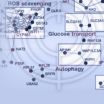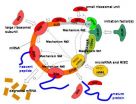(Press-News.org) HEIDELBERG, 31 July 2012 – Researchers have used computational analysis to identify a new Achilles heel for the treatment of drug-resistant breast cancer. The results, which are published in Molecular Systems Biology, reveal that the disruption of glucose metabolism is an effective therapeutic strategy for the treatment of tumours that have acquired resistance to front-line cancer drugs such as Lapatinib.
"The growth and survival of cancer cells can often be impaired by treatment with drugs that interfere with the actions of one or more oncogenes," said Prahlad Ram, the senior author of the study and Professor at the University of Texas MD Anderson Cancer Center, Houston, Texas. "However, the clinical benefits to patients are often short lived due to acquired drug resistance. Finding alternative intervention points or so-called new addictions for cancer cells is of critical importance for designing novel therapeutic strategies against tumours. Our results reveal specific new targets for drug intervention in the metabolic pathways of cancer cells and identify existing drugs that can be used to treat drug-resistant cancer."
Lapatinib is used for the treatment of patients with advanced or metastatic breast cancer in cases where tumours overexpress the ErbB2 gene. The ErbB2 gene provides instructions for making a specific growth factor receptor. If too much of this ErbB2 growth factor receptor is made, it can lead to cells that grow and divide continuously, one of the defining characteristics of breast cancer.
The scientists used microarrays to measure gene expression in breast cancer cells with and without treatment with Lapatinib. Computational analysis of more than 15000 gene interactions revealed four major populations of genes that were regulated in a significant way. Three of these groups were the regular suspects related to drug resistance, such as genes involved in oxidation and reduction reactions or cell cycle processes. A fourth group comprised a network of reactions linked to the deprivation of glucose.
Analysis of the gene expression networks of ErbB2-positive breast cancer patients revealed that the glucose deprivation network is linked to low survival rates of the patients. Computational screening of a library of existing drugs for therapeutics that target the glucose deprivation response identified several drugs that could be effective in treating drug-resistant breast cancer.
"By developing novel gene expression analysis algorithms and integrating diverse data, we have been able to look beyond changes in the immediate molecular signaling pathways of breast cancer cells and to consider the wider system of molecular networks within the cell," remarked Ram. "Our approach predicts new uses for existing drugs that impact the metabolism of breast cancer cells and may offer an expedient route to improved treatments for breast cancer patients."
The glucose-deprivation response network counteracts EGFR signalling in lapatinib resistant cells
INFORMATION:
Kakajan Komurov, Jen-Te Tseng, Melissa Muller, Elena G Seviour, Tyler J Moss, Lifeng Yang, Deepak Nagrath, Prahlad T Ram
Read the paper:
doi: 10.1038/msb.2012.25
Further information on Molecular Systems Biology is available at
http://www.nature.com/msb
Media Contacts
Barry Whyte
Head | Public Relations and Communications
Yvonne Kaul
Communications Offer
Tel: +49 6221 8891 108/111
communications@embo.org
About EMBO
EMBO stands for excellence in the life sciences. The organization enables the best science by supporting talented researchers, stimulating scientific exchange and advancing policies for a world-class European research environment.
EMBO is an organization of 1500 leading life scientist members that fosters new generations of researchers to produce world-class scientific results. EMBO helps young scientists to advance their research, promote their international reputations and ensure their mobility. Courses, workshops, conferences and scientific journals disseminate the latest research and offer training in cutting-edge techniques to maintain high standards of excellence in research practice. EMBO helps to shape science and research policy by seeking input and feedback from our community and by following closely the trends in science in Europe.
For more information: www.embo.org
Computational analysis identifies drugs to treat drug-resistant breast cancer
2012-07-31
ELSE PRESS RELEASES FROM THIS DATE:
Economic recession leads to increased entrepreneurship, MU study finds
2012-07-31
COLUMBIA, Mo. — The recent economic recession has caused many changes in the business landscape across the country, including high unemployment rates. Due to these high rates and the struggling economy, University of Missouri researchers have found that in recent years the number of Americans engaging in entrepreneurship has risen significantly. Maria Figueroa-Armijos, a doctoral candidate in the University of Missouri Truman School of Public Affairs, says that this trend could be positive for the future.
"We've seen similar trends occur in past economically slow periods ...
Chemistry on Mars video with Curiosity Rover from the American Chemical Society
2012-07-31
WASHINGTON, July 31, 2012 - After an epic 354-million-mile trek through space, the Mars Curiosity Rover is zooming along at 13,000 miles per hour toward a scheduled August 6 landing on the Red Planet to search for evidence of extraterrestrial life. The newest episode of the American Chemical Society's (ACS') award-winning Bytesize Science video series highlights Curiosity Rover's mission, scientific instrumentation and the role that chemistry plays in the search for life on other planets. The video, produced by the ACS Office of Public Affairs, is available at www.BytesizeScience.com. ...
Adding a '3D print' button to animation software
2012-07-31
Cambridge, Mass. - July 31, 2012 - Watch out, Barbie: omnivorous beasts are assembling in a 3D printer near you.
A group of graphics experts led by computer scientists at Harvard have created an add-on software tool that translates video game characters -- or any other three-dimensional animations -- into fully articulated action figures, with the help of a 3D printer.
The project is described in detail in the Association for Computing Machinery (ACM) Transactions on Graphics and will be presented at the ACM SIGGRAPH conference on August 7.
Besides its obvious consumer ...
Camouflage of moths: Secrets to invisibility revealed
2012-07-31
Moths are iconic examples of camouflage. Their wing coloration and patterns are shaped by natural selection to match the patterns of natural substrates, such as a tree bark or leaves, on which the moths rest. But, according to recent findings, the match in the appearance was not all in their invisibility.
Despite a long history of research on these iconic insects, whether moths behave in a way to increase their invisibility has not been determined. A research team from the Laboratory of Behavioral Ecology and Evolution at the Seoul National University has conducted an ...
Critically endangered whales sing like birds; New recordings hint at rebound
2012-07-31
When a University of Washington researcher listened to the audio picked up by a recording device that spent a year in the icy waters off the east coast of Greenland, she was stunned at what she heard: whales singing a remarkable variety of songs nearly constantly for five wintertime months.
Kate Stafford, an oceanographer with UW's Applied Physics Lab, set out to find if any endangered bowhead whales passed through the Fram Strait, an inhospitable, ice-covered stretch of sea between Greenland and the northern islands of Norway. Only around 40 sightings of bowhead whales, ...
Mathematicians find solution to biological building block puzzle
2012-07-31
An international team of mathematicians has proposed a new solution to understanding a biological puzzle that has confounded molecular biologists.
They have applied a mathematical model to work out the functioning of small molecules known as microRNAs – components of the body akin to the electronics in modern airplanes.
For a long time molecular biologists thought that the major role of RNA in living cells was to serve as a copy of a gene and a template for producing proteins, major cell building blocks. This belief had been changed at the end of 90s when it was found ...
Low-cost carbon capture gets X-rayed
2012-07-31
Diamond Light Source is being used to improve low cost methods for carbon capture. Scientists from the University of Leeds are using the UK's national synchrotron to investigate the efficiency of calcium oxide (CaO) based materials as carbon dioxide (CO2) sorbents. Their results, published in the journal of Energy & Environmental Science, provide an explanation for one of the key mechanisms involved. This new knowledge will inform efforts to improve the efficiency of this economically viable method of carbon capture and storage.
Current techniques for post-combustion ...
From microns to centimetres
2012-07-31
TORONTO, Ontario (July 31, 2012)– UofT researchers Axel Guenther Associate Professor in the Department of Mechanical and Industrial Engineering, cross-appointed to the Institute of Biomaterials and Biomedical Engineering (IBBME), and Milica Radisic, Associate Professor at IBBME and the Department of Chemical Engineering and Applied Chemistry, along with graduate students from their labs—Lian Leng, Boyang Zhang, and Arianna McAllister—have invented a new device that may allow for the uniform, large-scale engineering of tissue.
"There's a lot of interest in soft materials, ...
Childhood obesity may affect timing of puberty, create problems with reproduction
2012-07-31
CORVALLIS, Ore. – A dramatic increase in childhood obesity in recent decades may have impacts that go beyond the usual health concerns – it could be disrupting the timing of puberty and ultimately lead to a diminished ability to reproduce, especially in females.
A body of research suggests that obesity could be related to growing problems with infertility, scientists said in a recent review, in addition to a host of other physical and psycho-social concerns. The analysis was published in Frontiers in Endocrinology.
Human bodies may be scrambling to adjust to a problem ...
Study of zebra fish mouth formation may speak to Fraser syndrome hearing loss
2012-07-31
EUGENE, Ore. -- (July 31, 2012) -- Using mutant zebra fish, researchers studying the earliest formation of cartilage of the mouth believe they may have gotten a look at a mechanism involved in a genetic defect linked to Fraser syndrome deafness in humans.
Reporting in the Aug. 1 issue of the journal Development, they identify a potential developmental pathway worthy of more scrutiny in future research into Fraser syndrome, a many-faceted and rare recessive genetic disease. In humans, a mutation in the gene FRAS1, which plays a role in skin epithelial formation during ...




